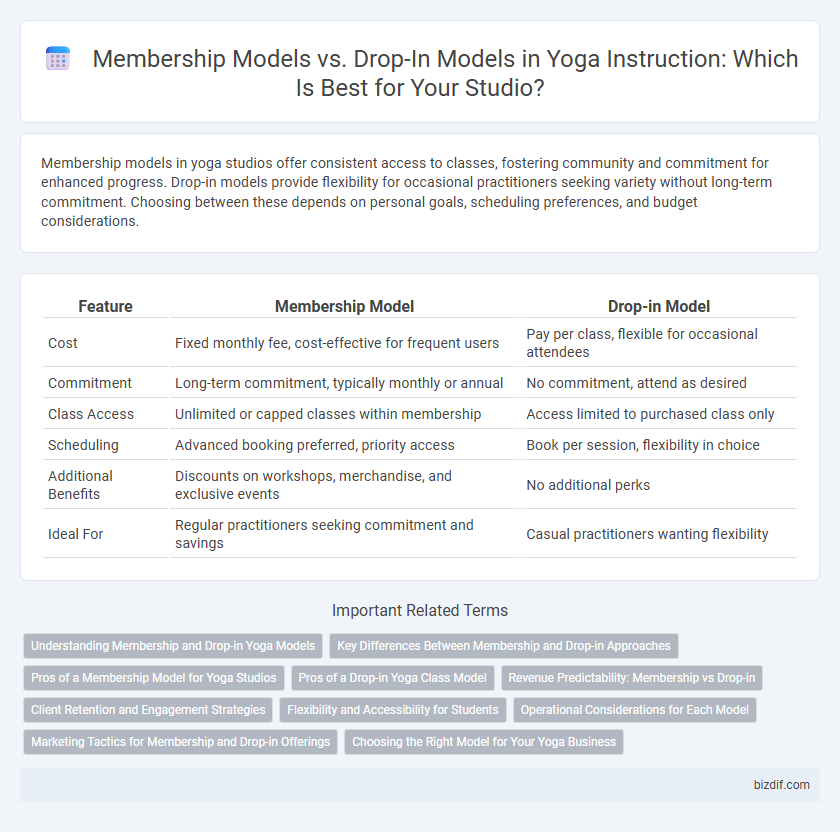Membership models in yoga studios offer consistent access to classes, fostering community and commitment for enhanced progress. Drop-in models provide flexibility for occasional practitioners seeking variety without long-term commitment. Choosing between these depends on personal goals, scheduling preferences, and budget considerations.
Table of Comparison
| Feature | Membership Model | Drop-in Model |
|---|---|---|
| Cost | Fixed monthly fee, cost-effective for frequent users | Pay per class, flexible for occasional attendees |
| Commitment | Long-term commitment, typically monthly or annual | No commitment, attend as desired |
| Class Access | Unlimited or capped classes within membership | Access limited to purchased class only |
| Scheduling | Advanced booking preferred, priority access | Book per session, flexibility in choice |
| Additional Benefits | Discounts on workshops, merchandise, and exclusive events | No additional perks |
| Ideal For | Regular practitioners seeking commitment and savings | Casual practitioners wanting flexibility |
Understanding Membership and Drop-in Yoga Models
Membership yoga models offer unlimited or a fixed number of classes per month, providing consistent access and encouraging long-term practice, often including perks like workshops and discounts. Drop-in models allow flexible, pay-per-class attendance, catering to sporadic schedules and offering variety without commitment. Understanding these models helps instructors tailor offerings to diverse student needs, balancing revenue stability with accessibility.
Key Differences Between Membership and Drop-in Approaches
Membership models in yoga instruction offer consistent access to classes with fixed monthly fees, fostering long-term commitment and community building. Drop-in models provide flexibility for clients to pay per class without ongoing obligations, appealing to those with irregular schedules or just exploring. Key differences include payment structure, access frequency, and commitment level, which directly impact budgeting, motivation, and class attendance consistency.
Pros of a Membership Model for Yoga Studios
Membership models for yoga studios provide consistent revenue streams that enhance financial stability and enable long-term planning. Regular members tend to develop stronger community ties and greater commitment to their practice, resulting in higher retention rates. This model also allows studios to offer personalized programming and priority class access, improving overall customer satisfaction and engagement.
Pros of a Drop-in Yoga Class Model
Drop-in yoga class models offer unmatched flexibility, allowing practitioners to attend sessions based on their own schedules without long-term commitments. This approach attracts a diverse range of students, from beginners sampling different styles to experienced yogis seeking variety in their practice. The absence of membership fees lowers the financial barrier, encouraging spontaneous participation and fostering a dynamic yoga community.
Revenue Predictability: Membership vs Drop-in
Membership models generate more consistent revenue due to recurring payments, allowing yoga studios to forecast income and manage expenses with greater accuracy. Drop-in models depend on variable attendance, creating unpredictable cash flow that can challenge financial stability. Studios aiming for sustainable growth often prioritize membership plans to ensure steady revenue streams.
Client Retention and Engagement Strategies
Membership models for yoga instruction foster higher client retention through consistent scheduling and incentivized long-term commitment, enhancing engagement with personalized progress tracking and community-building activities. Drop-in models appeal to occasional clients seeking flexibility but often require targeted marketing and promotional offers to maintain sporadic attendance and engagement. Combining membership perks with occasional drop-in options can optimize client retention while accommodating diverse user preferences.
Flexibility and Accessibility for Students
Membership models offer students consistent access to a variety of yoga classes at a fixed monthly rate, providing predictable scheduling and enhanced commitment to practice. Drop-in models prioritize flexibility, allowing students to attend sessions without long-term obligations, ideal for those with irregular schedules or varying availability. Both models improve accessibility, but membership enhances routine and community engagement, while drop-in caters to spontaneous and occasional participation.
Operational Considerations for Each Model
Membership models in yoga studios require sustained client engagement, predictable revenue streams, and efficient scheduling systems to manage recurring classes and member benefits. Drop-in models demand flexible staffing, dynamic class size adjustments, and robust point-of-sale systems to accommodate fluctuating attendance and maximize per-class profitability. Operationally, membership frameworks excel in long-term planning and community building, while drop-in structures prioritize adaptability and immediate revenue capture.
Marketing Tactics for Membership and Drop-in Offerings
Targeted email campaigns highlighting exclusive perks drive membership sign-ups by emphasizing long-term value and community access. Social media ads promoting flexible drop-in classes appeal to casual attendees seeking convenience without commitment. Offering limited-time discounts and referral incentives enhances engagement and maximizes conversions for both membership and drop-in models.
Choosing the Right Model for Your Yoga Business
Choosing the right membership model or drop-in model for your yoga business depends on customer preferences and revenue goals. Membership models provide steady monthly income and build community, while drop-in models offer flexibility and attract occasional clients. Analyzing local market demand and financial projections ensures optimal alignment with your business strategy and client retention rates.
Membership Models vs Drop-in Models Infographic

 bizdif.com
bizdif.com